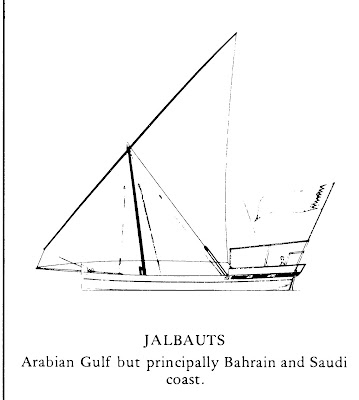Tacking a dhow, with its huge and heavy settee spar, is apparently not as difficult as might be assumed, provided that a sizable crew is available. Clifford W. Hawkins, in his book The Dhow: an Illustrated History of the Dhow and its World , describes observing the process from aboard a small boat:
, describes observing the process from aboard a small boat:
"As we closed in on the sambuk [a common two-masted dhow of the Red Sea, Gulf of Aden, South Arabia, and East Africa] I could see that some action was about to take place. The crew, rising off their haunches, casually sauntered to working positions; one right up int he bows at the mains'l tack, four at the shrouds, two to the yard's backhaul and a small group ready to handle the main sheet. These were the action stations for wearing ship, the preliminary operation for sailing on the opposite tack. When the critical moment arrived the helmsman threw over the wheel to bring the wind aft and the big mains'l was allowed to fly forward with the release of its sheet. Every member of the crew now came into action to carry the operation through. The two shrouds that had been taut to windward were eased off and the other pair set up on what was already becoming the new windward side. The yard, which had been freed from the masthead by letting loose the parrel, was at the same time hauled momentarily by the foot, so allowing it to pass over to the forthcoming leeward side. The flying sail was then hauled back and sheeted home on the opposite side to where it had been. it filled out and the sambuk was away on the new tack.
"Surprisingly the operation of wearing ship was not a long or very difficult procedure. The dhow turned unhesitatingly on its heel and was away on the new board with the loss of very little ground. It is possible for a dhow to go about, head to wind, but in doing so it would be in a somewhat similar position to a square-rigged sailing vessel caught aback with the great settee sail afoul of the mast and rigging. In an emergency a dhow could sail, after a fashion, like this and there is in fact one vessel, the Tuticorin thoni [a three-masted, Indian dhow], that habitually sails with the yard on one of its masts slung to port and the other to starboard so that one sail is alternately pulling free or is afoul of the mast as the thoni tacks. The thoni has an entirely unorthodox manner of setting up its rigging and it is this that allows the vessel to tack and not wear as other dhows do."
By the way, two-masted dhows all appear to be "ketches," with their mainmast in front. Hawkins shows no schooner dhows in his book. Below are just four of the 28 or so dhow types Hawkins documents; they are mostly distinguished by their rigs, but other differences include their size, the shape and rake of their stem and sternposts, by whether they are transom-sterned or double-ended, and a number of other characteristics.















No comments:
Post a Comment